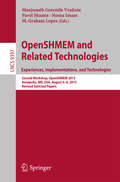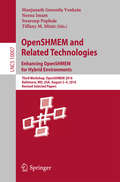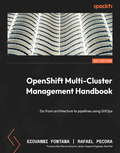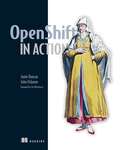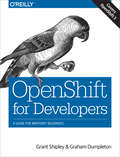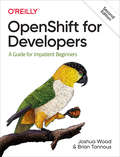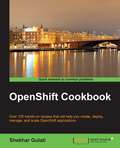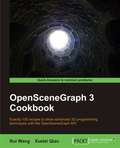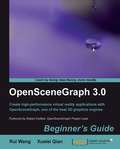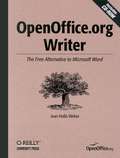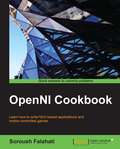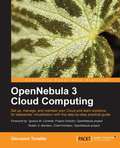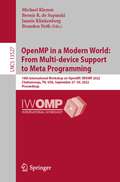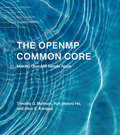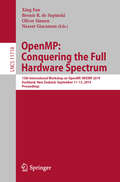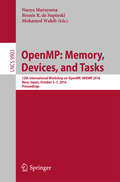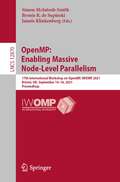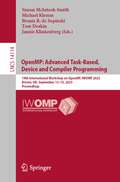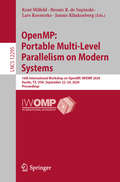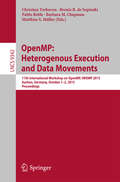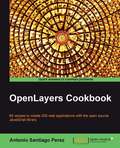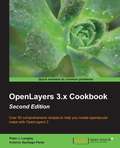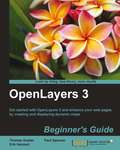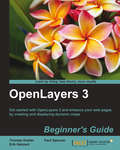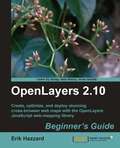- Table View
- List View
OpenSHMEM and Related Technologies. Experiences, Implementations, and Technologies
by Manjunath Gorentla Venkata Pavel Shamis Neena Imam M. Graham LopezThis book constitutes the proceedings of the SecondOpenSHMEM Workshop, held in Annapolis, MD, USA, in August 2015. The 12 technical papers and one short position paperspresented in this book were carefully reviewed and selected from 17submissions. The topics of the workshop included extensions to the OpenSHMEMAPI, implementation of the API for current and emerging architectures, tools todebug and profile OpenSHMEM programs, experience porting applications to theOpenSHMEM programming model, and changes to the OpenSHMEM specification toaddress the needs of programming exascale systems.
OpenSHMEM and Related Technologies. Enhancing OpenSHMEM for Hybrid Environments
by Manjunath Gorentla Venkata Neena Imam Swaroop Pophale Tiffany M. MintzThis book constitutes the proceedings of the Third OpenSHMEM Workshop, held in Baltimore, MD, USA, in August 2016. The 14 full papers and 3 short papers presented were carefully reviewed and selected from 25 submissions. The papers discuss a variety of ideas of extending the OpenSHMEM specification and making it efficient for current and next generation systems. This included active messages, non-blocking APIs, fault tolerance capabitlities, exploring implementation of OpenSHMEM using communication layers such as OFI and UCX and implementing OpenSHMEM for heterogeneous architectures.
OpenShift Multi-Cluster Management Handbook: Go from architecture to pipelines using GitOps
by Giovanni Fontana Rafael Pecora Marcos AmorimDiscover best practices for designing and scaling robust OpenShift clusters' architecture for different workloadsManage multiple clusters on-premise or in the cloud using multi-cluster management tools to keep them secure and compliantImplement multi-cluster CI/CD on OpenShift using GitOpsKey FeaturesDiscover best practices to design robust OpenShift architecture and scale them to different workloadsUnderstand the minimal collection of topics you should consider in your container security strategyImplement multi-cluster CI/CD on OpenShift using GitOpsBook DescriptionFor IT professionals working with Red Hat OpenShift Container Platform, the key to maximizing efficiency is understanding the powerful and resilient options to maintain the software development platform with minimal effort. OpenShift Multi-Cluster Management Handbook is a deep dive into the technology, containing knowledge essential for anyone who wants to work with OpenShift.This book starts by covering the architectural concepts and definitions necessary for deploying OpenShift clusters. It then takes you through designing Red Hat OpenShift for hybrid and multi-cloud infrastructure, showing you different approaches for multiple environments (from on-premises to cloud providers). As you advance, you'll learn container security strategies to protect pipelines, data, and infrastructure on each layer. You'll also discover tips for critical decision making once you understand the importance of designing a comprehensive project considering all aspects of an architecture that will allow the solution to scale as your application requires.By the end of this OpenShift book, you'll know how to design a comprehensive Red Hat OpenShift cluster architecture, deploy it, and effectively manage your enterprise-grade clusters and other critical components using tools in OpenShift Plus.What you will learnUnderstand the important aspects of OpenShift cluster architectureDesign your infrastructure to run across hybrid cloudsDefine the best strategy for multitenancy on OpenShiftDiscover efficient troubleshooting strategies with OpenShiftBuild and deploy your applications using OpenShift Pipelines (Tekton)Work with ArgoCD to deploy your applications using GitOps practicesMonitor your clusters' security using Red Hat Advanced Cluster SecurityWho this book is forThis book is for a wide range of IT professionals using or looking to use OpenShift with a hybrid/multi-cloud approach. In this book, IT architects will find practical guidance on OpenShift clusters' architecture, while Sysadmins, SREs, and IT operators will learn more about OpenShift deployment, troubleshooting, networking, security, and tools to manage multiple clusters from a single pane. For DevOps engineers, this book covers CI/CD strategies for multiple clusters using GitOps. Equipped with just basic knowledge of containerization and Kubernetes, you're ready to get started.
OpenShift in Action
by John Osborne Jamie DuncanSummaryOpenShift in Action is a full reference to Red Hat OpenShift that breaks down this robust container platform so you can use it day-to-day. Combining Docker and Kubernetes, OpenShift is a powerful platform for cluster management, scaling, and upgrading your enterprise apps. It doesn't matter why you use OpenShift—by the end of this book you'll be able to handle every aspect of it, inside and out! Foreword by Jim Whitehurst, Red Hat. Purchase of the print book includes a free eBook in PDF, Kindle, and ePub formats from Manning Publications.About the TechnologyContainers let you package everything into one neat place, and with Red Hat OpenShift you can build, deploy, and run those packages all in one place! Combining Docker and Kubernetes, OpenShift is a powerful platform for cluster management, scaling, and upgrading your enterprise apps.About the BookOpenShift in Action is a full reference to Red Hat OpenShift that breaks down this robust container platform so you can use it day-to-day. Starting with how to deploy and run your first application, you'll go deep into OpenShift. You'll discover crystal-clear explanations of namespaces, cgroups, and SELinux, learn to prepare a cluster, and even tackle advanced details like software-defined networks and security, with real-world examples you can take to your own work. It doesn't matter why you use OpenShift—by the end of this book you'll be able to handle every aspect of it, inside and out! What's InsideWritten by lead OpenShift architectsRock-solid fundamentals of Docker and KubernetesKeep mission-critical applications up and runningManage persistent storageAbout the ReaderFor DevOps engineers and administrators working in a Linux-based distributed environment.About the AuthorsJamie Duncan is a cloud solutions architect for Red Hat, focusing on large-scale OpenShift deployments. John Osborne is a principal OpenShift architect for Red Hat.Table of ContentsPART 1 - FUNDAMENTALSGetting to know OpenShift Getting started Containers are Linux PART 2 - CLOUD-NATIVE APPLICATIONSWorking with services Autoscaling with metrics Continuous integration and continuous deployment PART 3 - STATEFUL APPLICATIONS Creating and managing persistent storage Stateful applications PART 4 - OPERATIONS AND SECURITYAuthentication and resource access Networking Security
OpenShift for Developers: A Guide for Impatient Beginners
by Graham Dumpleton Grant ShipleyKeen to build web applications for the cloud? Get a quick hands-on introduction to OpenShift, the open source Platform as a Service (PaaS) offering from Red Hat. With this practical guide, you’ll learn the steps necessary to build, deploy, and host a complete real-world application on OpenShift without having to slog through long, detailed explanations of the technologies involved. OpenShift enables you to use Docker application containers and the Kubernetes cluster manager to automate the way you create, ship, and run applications. Through the course of the book, you’ll learn how to use OpenShift and the Wildfly application server to build and then immediately deploy a Java application online. Learn about OpenShift’s core technology, including Docker-based containers and Kubernetes; Use a virtual machine with OpenShift installed and configured on your local environment; Create and deploy your first application on the OpenShift platform; Add language runtime dependencies and connect to a database; Trigger an automatic rebuild and redeployment when you push changes to the repository; Get a working environment up in minutes with application templates; Use commands to check and debug your application; Create and build Docker-based images for your application.
OpenShift for Developers
by Joshua Wood Brian TannousReady to build cloud native applications? Get a hands-on introduction to daily life as a developer crafting code on OpenShift, the open source container application platform from Red Hat. Creating and packaging your apps for deployment on modern distributed systems can be daunting. Too often, adding infrastructure value can complicate development. With this practical guide, you'll learn how to build, deploy, and manage a multitiered application on OpenShift.Authors Joshua Wood and Brian Tannous, principal developer advocates at Red Hat, demonstrate how OpenShift speeds application development. With the Kubernetes container orchestrator at its core, OpenShift simplifies and automates the way you build, ship, and run code. You'll learn how to use OpenShift and the Quarkus Java framework to develop and deploy apps using proven enterprise technologies and practices that you can apply to code in any language.Learn the development cycles for building and deploying on OpenShift, and the tools that drive themUse OpenShift to build, deploy, and manage the ongoing lifecycle of an n-tier applicationCreate a continuous integration and deployment pipeline to build and deploy application source code on OpenShiftAutomate scaling decisions with metrics and trigger lifecycle events with webhooks
OpenShift Cookbook
by Shekhar GulatiIf you are a web application developer who wants to use the OpenShift platform to host your next big idea but are looking for guidance on how to achieve this, then this book is the first step you need to take. This is a very accessible cookbook where no previous knowledge of OpenShift is needed.
OpenSceneGraph 3 Cookbook
by Rui Wang Xuelei QianThis is a cookbook full of recipes with practical examples enriched with code and the required screenshots for easy and quick comprehension. You should be familiar with the basic concepts of the OpenSceneGraph API and should be able to write simple programs. Some OpenGL and math knowledge will help a lot, too.
OpenSceneGraph 3.0: Beginner's Guide
by Rui Wang Xuelei QianWritten with a fast-paced but friendly and engaging approach, this Packt Beginner's Guide is designed to be placed alongside the computer as your guide and mentor. Step-by-step tutorials are bolstered by explanations of the reasoning behind what you are doing. You will quickly pick up the necessary skills, tips, and tricks for creating successful 3D graphics with practical examples that help you to learn by experiment and play.This book is intended for software developers who are new to OpenSceneGraph and considering using it in their applications. It is assumed that you have basic knowledge of C++ before using this book, especially the standard template library (STL) constructs, of which OSG makes extensive use. Some familiarity with design patterns as implemented in C++ is also useful, but is not required.You need to be familiar with OpenGL, the standard cross-platform low-level 3D graphics API. We'll meet some maths in the book--geometry and linear algebra--and familiarity with these topics will be great, but you don't need to be a maths whiz to use this book.
OpenOffice.org Writer
by Jean Hollis WeberThanks to OpenOffice.org, there is an alternative to Microsoft Word. If you've ever been frustrated by Word's quirks and limitations--including its price tag--and longed for a practical alternative, then it's time to break free. OpenOffice.org is the free, open source office suite and its word processor, Writer, has proven extremely popular with both Windows and Linux users. How good can it be if it's free? you might ask. And how much trouble will it be to install and learn? A quick tour of the program will show you: the features you use regularly--from formatting and spell check to using templates and creating indexes --are all there. And Writer's intuitive, surprisingly familiar interface lets you navigate with ease. To quickly master the ins and outs of Writer, you'll want a copy of OpenOffice.org Writer: The Free Alternative to Microsoft Word . This handy reference is packed with essential information to help you learn the basics of Writer and become adept with its advanced features. Written for intermediate and advanced users of word processing programs, OpenOffice.org Writer: The Free Alternative to Microsoft Word provides guidance for common and advanced word processing tasks. With this book, you'll learn how to: Set up OOoWriter to work your way Write, edit, and review documents Control page layout Use templates and styles effectively Get the most from using fields Work with Tables of contents, indexes, bibliographies Manage large or complex documents Insert, edit and create graphics Make a smooth transition from Microsoft Word OpenOffice.org Writer: The Free Alternative to Microsoft Word provides guidance for anyone who wants to break out of the Word rut. Its detailed Table of Contents make it a handy reference for even the most experienced word processing users who want to get up to speed quickly with this program, or make sure they're taking full advantage of OOo Writer's features. With the complete office suite included on a CD (which you can install on as many machines as you like), this book makes using Writer an easy decision. OpenOffice.org Writer: The Free Alternative to Microsoft Word is part of the O'Reilly Community Press Series. Unlike classic O'Reilly animal books, O'Reilly's role in the series is limited to providing manufacturing and distribution services rather than editorial development, so that each Community Press title reflects the editorial voice and organization of the community that has created it.
OpenNI Cookbook
by Soroush FalahatiThis is a Cookbook with plenty of practical recipes enriched with explained code and relevant screenshots to ease your learning curve. If you are a beginner or a professional in NIUI and want to write serious applications or games, then this book is for you. Even OpenNI 1 and OpenNI 1.x programmers who want to move to new versions of OpenNI can use this book as a starting point. This book uses C++ as the primary language but there are some examples in C# and Java too, so you need to have about a basic working knowledge of C or C++ for most cases.
OpenNebula 3 Cloud Computing
by Giovanni ToraldoThis is a step-by-step practical guide to get you started easily with openNebula. It guides you to build, maintain, and configure your cloud infrastructure, providing real-world examples in a simple and coherent manner. If you are a GNU/Linux system administrator with no experience with virtualization or cloud computing but eager to learn about it, or you are thwarted by your current virtualized infrastructure, this book is for you. You are expected to have some basic knowledge of GNU/Linux, with knowledge of basic package management tools and system configuration.
OpenMP in a Modern World: 18th International Workshop on OpenMP, IWOMP 2022, Chattanooga, TN, USA, September 27–30, 2022, Proceedings (Lecture Notes in Computer Science #13527)
by Michael Klemm Bronis R. de Supinski Jannis Klinkenberg Brandon NethThis book constitutes the proceedings of the 18th International Workshop on OpenMP, IWOMP 2022, held in Chattanooga, TN, USA, in September 2022.The 11 full papers presented in this volume were carefully reviewed and selected for inclusion in this book from the 13 submissions. The papers are organized in topical sections named: OpenMP and multiple nodes; exploring new and recent OpenMP extensions; effectie use of advanced heterogeneous node architectures; OpenMP tool support; OpenMP and multiple translation units.Chapter "Improving Tool Support for Nested Parallel Regions with Introspection Consistency" is publshed Open Access and licensed under the terms of the Creative Commons Attribution 4.0 International License (http://creativecommons.org/licenses/by/4.0/).
The OpenMP Common Core: Making OpenMP Simple Again (Scientific and Engineering Computation)
by Timothy G. Mattson Yun (Helen) He Alice E. KonigesHow to become a parallel programmer by learning the twenty-one essential components of OpenMP.This book guides readers through the most essential elements of OpenMP—the twenty-one components that most OpenMP programmers use most of the time, known collectively as the “OpenMP Common Core.” Once they have mastered these components, readers with no prior experience writing parallel code will be effective parallel programmers, ready to take on more complex aspects of OpenMP. The authors, drawing on twenty years of experience in teaching OpenMP, introduce material in discrete chunks ordered to support effective learning. OpenMP was created in 1997 to make it as simple as possible for applications programmers to write parallel code; since then, it has grown into a huge and complex system. The OpenMP Common Core goes back to basics, capturing the inherent simplicity of OpenMP. After introducing the fundamental concepts of parallel computing and history of OpenMP's development, the book covers topics including the core design pattern of parallel computing, the parallel and worksharing-loop constructs, the OpenMP data environment, and tasks. Two chapters on the OpenMP memory model are uniquely valuable for their pedagogic approach. The key for readers is to work through the material, use an OpenMP-enabled compiler, and write programs to experiment with each OpenMP directive or API routine as it is introduced. The book's website, updated continuously, offers a wide assortment of programs and exercises.
OpenMP: 15th International Workshop on OpenMP, IWOMP 2019, Auckland, New Zealand, September 11–13, 2019, Proceedings (Lecture Notes in Computer Science #11718)
by Xing Fan Bronis R. de Supinski Oliver Sinnen Nasser GiacamanThis book constitutes the proceedings of the 15th International Workshop on Open MP, IWOMP 2019, held in Auckland, New Zealand, in September 2019. The 22 full papers presented in this volume were carefully reviewed and selected for inclusion in this book. The papers are organized in topical sections named: best paper; tools, accelerators, compilation, extensions, tasking, and using OpenMP.
OpenMP: Memory, Devices, and Tasks
by Naoya Maruyama Bronis R. Supinski Mohamed WahibThis book constitutes the proceedings of the 12th International Workshop on OpenMP, IWOMP 2016, held in Nara, Japan, in October 2016. The 24 full papers presented in this volume were carefully reviewed and selected from 28 submissions. They were organized in topical sections named: applications, locality, task parallelism, extensions, tools, accelerator programming, and performance evaluations and optimization.
OpenMP: 17th International Workshop on OpenMP, IWOMP 2021, Bristol, UK, September 14–16, 2021, Proceedings (Lecture Notes in Computer Science #12870)
by Simon McIntosh-Smith Bronis R. de Supinski Jannis KlinkenbergThis book constitutes the proceedings of the 17th International Workshop on OpenMP, IWOMP 2021, held virtually in September 2021 and hosted by the High Performance Computing research group at the University of Bristol, UK.The 15 full papers presented in this volume were carefully reviewed and selected for inclusion in this book. The papers are organized in topical sections named: synchronization and data; tasking expansions; applications; case studies; and heterogenous computing and memory. Chapter ‘FOTV: A Generic Device Offloading Framework for OpenMP’ is available open access under a Creative Commons Attribution 4.0 International License via link.springer.com.
OpenMP: 19th International Workshop on OpenMP, IWOMP 2023, Bristol, UK, September 13–15, 2023, Proceedings (Lecture Notes in Computer Science #14114)
by Simon McIntosh-Smith Michael Klemm Bronis R. de Supinski Tom Deakin Jannis KlinkenbergThis book constitutes the proceedings of the 19th International Workshop on OpenMP, IWOMP 2023, held in Bristol, UK, during September 13–15, 2023.The 15 full papers presented in this book were carefully reviewed and selected from 20 submissions. The papers are divided into the following topical sections: OpenMP and AI; Tasking Extensions; OpenMP Offload Experiences; Beyond Explicit GPU Support; and OpenMP Infrastructure and Evaluation.
OpenMP: 16th International Workshop on OpenMP, IWOMP 2020, Austin, TX, USA, September 22–24, 2020, Proceedings (Lecture Notes in Computer Science #12295)
by Kent Milfeld Bronis R. de Supinski Lars Koesterke Jannis KlinkenbergThis book constitutes the proceedings of the 16th International Workshop on OpenMP, IWOMP 2020, held in Austin, TX, USA, in September 2020. The conference was held virtually due to the COVID-19 pandemic. The 21 full papers presented in this volume were carefully reviewed and selected for inclusion in this book. The papers are organized in topical sections named: performance methodologies; applications; OpenMP extensions; performance studies; tools; NUMA; compilation techniques; heterogeneous computing; and memory.The chapters ‘A Case Study on Addressing Complex Load Imbalance in OpenMP’ and ‘A Study of Memory Anomalies in OpenMP Applications’ are available open access under a Creative Commons Attribution 4.0 License via link.springer.com.
OpenMP: Heterogenous Execution and Data Movements
by Matthias S. Müller Barbara M. Chapman Pablo Reble Bronis R. de Supinski Christian TerbovenThis book constitutes the refereed proceedings of the 11th International Workshop on OpenMP, held in Aachen, Germany, in October 2015. The 19 technical full papers presented were carefully reviewed and selected from 22 submissions. The papers are organized in topical sections on applications, accelerator applications, tools, extensions, compiler and runtime, and energy.
OpenLayers Cookbook
by Antonio Santiago PerezThis cookbook follows a problem-solution approach to doing important tasks and is packed with examples accompanied by the necessary code and screenshots. If you are a GIS-related professional with some basic knowledge of web technologies and want to start or gain in-depth knowledge of creating web mapping applications, this book is written for you. The recipes are appropriately mixed to suit JavaScript newbies or experts and cover basic to advanced topics on OpenLayers.
OpenLayers 3.x Cookbook - Second Edition
by Peter J. Langley Antonio Santiago PerezOver 50 comprehensive recipes to help you create spectacular maps with OpenLayers 3 About This Book * Create highly customized mapping apps for the web with rich interactivity and diverse content using JavaScript * See how successful mapping apps work and how they integrate with third-party services * Packed full of code examples, screenshots, and explanations from professionals in the industry Who This Book Is For If you are a GIS-related professional with basic knowledge of web technologies and want to gain in-depth knowledge of creating web mapping applications, then this book is for you. The recipes will be appropriately mixed to suit JavaScript beginners or experts and cover basic to advanced topics on OpenLayers. What You Will Learn * Create stunning maps, and understand projection. * Add customized raster and vector layers * Work with important tile providers * Work with OGCs, WMS, and WFS compliant servers * Read/write features from/to different data sources * Style features to improve their visualization * Understand events and work with the main controls * Enhance maps with HTML5 technologies such as Geolocation In Detail Data visualization and analytics has become an important task across all technology-based industries. OpenLayers 3,is one of the most important and complete open source JavaScript mapping libraries today. Throughout this book, you will go through recipes that expose various features of OpenLayers 3, allowing you to gain an insight into building complex GIS web applications. You'll get to grips with the basics of creating a map with common functionality and quickly advance to more complicated solutions that address modern challenges. You will explore into maps, raster and vector layers and styling in-depth. This book also includes problem solving and how-to recipes for the most common and important tasks. The range of recipes includes: creating basic maps, working with raster and vector layers, understanding events,working with the main controls, reading features from different data sources, styling features, and understanding the underlying architecture. It will also cover solutions and optimizations to challenges commonly faced in modern applications. Style and approach This book teaches you how to create stunning maps that are highly interactive and visually appealing with the help of 50 handpicked recipes. Each recipe will address your need to visualize data on a map. Just follow the steps in the recipes to create maps of your choice in no time.
OpenLayers 3 Beginner's Guide
by Thomas Gratier<P><P>About This Book <P><P>Create and display maps online with the latest HTML5 features available, using the OpenLayers 3 library <P><P>Learn how to interact with the map and learn best practices to improve the loading time for a map <P><P>A practical beginner's guide, which also serves as a quick reference with useful screenshots and detailed code explanations <P><P>Who This Book Is For <P><P>Whether you are a hobbyist or a professional web developer, if you wish to use maps on your website, then this book is for you. A basic understanding of JavaScript will be helpful, but is not necessary. If you've never worked with maps before, this book will introduce you to some common mapping topics and will guide you through the OpenLayers library. Experienced developers can also use this book as a reference to OpenLayers 3 components and to further enhance their knowledge. <P><P>What You Will Learn <P><P>Build a complete, real-world OpenLayers application optimized for production use <P><P>Work with different raster data sources to create a base map <P><P>Overlay vector data sources and work with vector features directly <P><P>Customize the appearance of vector layers <P><P>Understand the concept of map projections and how to use them <P><P>Manage and work with interactions such as click and touch <P><P>Work with controls to enhance the user experience <P><P>Target mobile platforms and explore challenges presented by mobile development <P><P>In Detail <P><P>This book is a practical, hands-on guide that provides you with all the information you need to get started with mapping using the OpenLayers 3 library. <P><P>The book starts off by showing you how to create a simple map. Through the course of the book, we will review each component needed to make a map in OpenLayers 3, and you will end up with a full-fledged web map application. You will learn the key role of each OpenLayers 3 component in making a map, and important mapping principles such as projections and layers. You will create your own data files and connect to backend servers for mapping. A key part of this book will also be dedicated to building a mapping application for mobile devices and its specific components.
OpenLayers 3: Beginner's Guide
by Thomas Gratier Paul SpencerWhether you are a hobbyist or a professional web developer, if you wish to use maps on your website, then this book is for you. A basic understanding of JavaScript will be helpful, but is not necessary. If you've never worked with maps before, this book will introduce you to some common mapping topics and will guide you through the OpenLayers library. Experienced developers can also use this book as a reference to OpenLayers 3 components and to further enhance their knowledge.
OpenLayers 2.10 Beginner's Guide
by Erik HazzardThis is a beginner's guide with the essential screenshots and clearly explained code, which also serves as a reference.This book is for anyone who has any interest in using maps on their website, from hobbyists to professional web developers. OpenLayers provides a powerful, but easy-to-use, pure JavaScript and HTML (no third-party plug-ins involved) toolkit to quickly make cross-browser web maps. A basic understanding of JavaScript will be helpful, but there is no prior knowledge required to use this book. If you've never worked with maps before, this book will introduce you to some common mapping topics and gently guide you through the OpenLayers library. If you're an experienced application developer, this book will also serve as a reference to the core components of OpenLayers.
